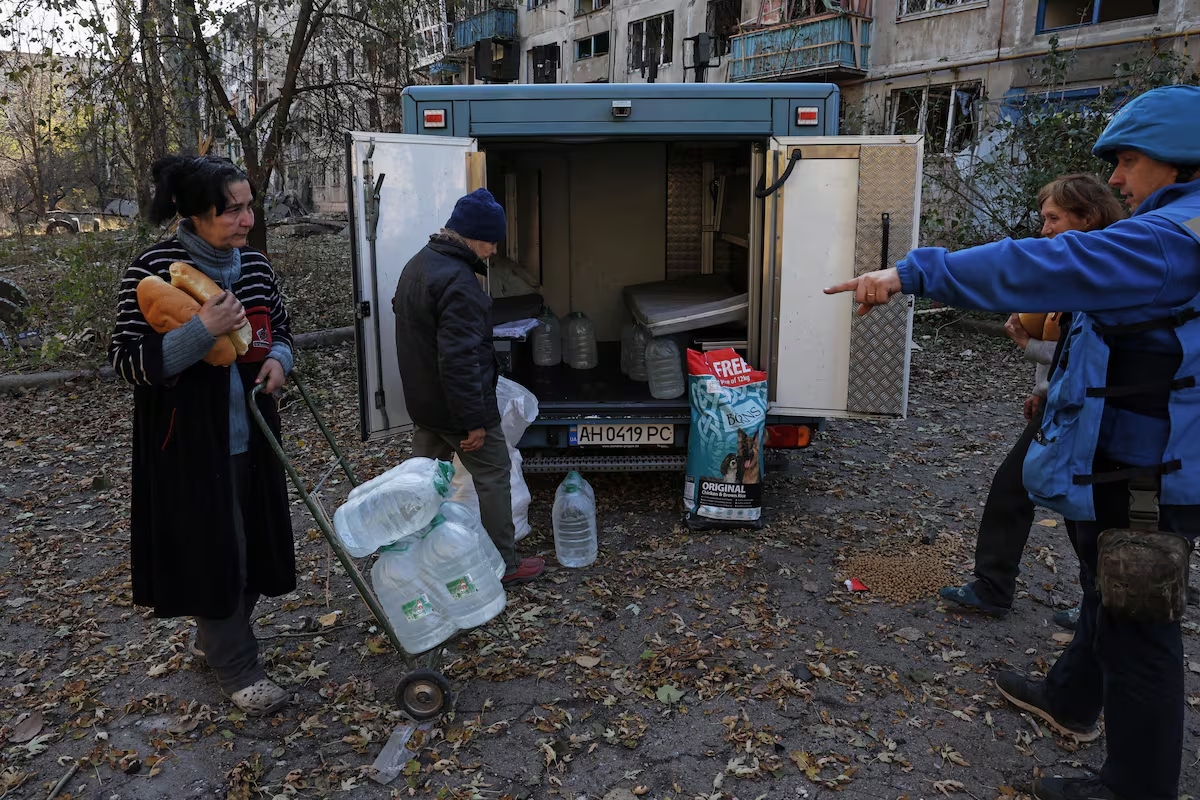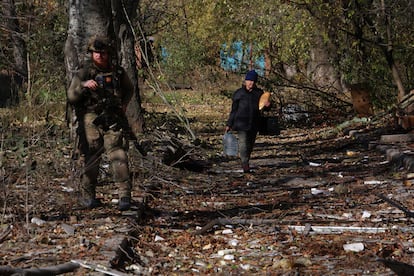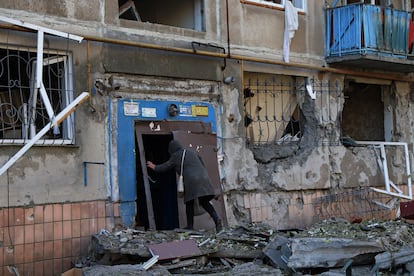
“A month ago, I tried to evacuate an elderly woman and her husband, but they refused. Two days ago, the police found the woman’s body eaten by cats in the house and took the man away.” In the maelstrom of war in eastern Ukraine, Evgeny Tkachev has little time to think, but experiences like this pile up like a burden. The 55-year-old man risks his life once or several times each day in the chauffeured NGO Proliska’s armored van into the town of Kostiantyniuca.
They move at full speed along roads covered in nets in some sections, as if forming tunnels to try to avoid drone attacks. It doesn’t matter whether the blue vehicle has a clear sign of a humanitarian organization. It will also become a target, as the van was severely damaged on November 8, two weeks after the mission this newspaper accompanied.
Kostynivka, in eastern Donetsk, is about 4 kilometers away and under 24-hour siege by Kremlin forces using drones, artillery, Grad missiles and air bombs. “A month ago, there were not as many attacks during the day as there are now,” Tkachev said. “They are attacking even when there is no curfew and there is an evacuation. They don’t care that this is the time when more people are out on the streets,” he added. When advancing and attempting to capture a city, the invaders will shoot at anything, civilian or military. The town, where only a few thousand of its 70,000 pre-war residents remain, has already been nearly wiped out by them. Kiev controls only 30% of Donetsk Oblast and very little of Lugansk Oblast. Both make up the Donbass region, an industrial bastion in the east favored by Russian President Vladimir Putin.
Neighbors come, almost silently, from the back of the van to collect bread and water. They have to overcome all kinds of debris and an endless carpet of leaves falling from the trees due to the shock waves of the explosions. “Every day we wake up and thank God that we are still alive,” Lilia says in Russian. The language remains the dominant language in this region of Ukraine, despite the Ukrainian state’s campaign to exclude Russian language and culture, viewing it as a propaganda tool for Moscow. Before leaving, the woman explained that her father and mother, who are nearly 80 years old, were unable to stay in bed. People are also seen entering doorways of buildings with structural damage that prevents them from standing for more than a few minutes.
They move like ghosts on foot or on bicycles, driven by a sense of duty to survive, even though they know they are under constant surveillance by Russian forces from above. This environment, dominated by destruction and desolation, has everything to record a film. “Evacuation, evacuation!” Tkachev shouted over and over again for them to hear. His voice reflects off the huge rubble, and the shards of glass under his boots announce his arrival. Following in their footsteps makes you wonder if there are really people still in the middle of this hell, and at the same time, why they insist that hell not be abandoned. It’s not just bombing. With no water, electricity, or heat, just going to an open store or collecting buckets of water from a well is a dangerous mission.
“Drones fly like flies. They don’t stop. We have to run, we have to walk fast. They don’t stop,” said Ole Borodym, 56, who held out in Kostiantyniuka until an aerial bomb destroyed the five-story building where he lived from top to bottom hours earlier. He and the rest of his neighbors, who spent the night in the basement, were miraculously rescued. The man sat in the back of the van, drinking water and eating bread as he checked his passport, his hands shaking uncontrollably.
“We went to sleep around 11:30 p.m. The bomb hit the house. The impact was huge. Our part didn’t collapse, so we were able to get out of the basement. The impact was so strong… there was nothing left between the gates. Only the basement floor. And it was a five-story building,” he says, still shocked by the experience. They all survived and managed to reach the hospital in the dark. In the morning, a group of soldiers appeared and told Borodym that he had agreed to be evacuated. “I left behind two apartments, both of which were destroyed. I couldn’t take anything with me,” he laments, although a reception center has already been set up in Kramatorsk, about 20 kilometers from Kostiantynivka.

Unlike other places such as Pokrovsk, military personnel are rarely seen on the city’s streets, as urban warfare has not yet begun. You rarely see them driving around in cars to avoid attacks. “The situation is very bad, especially in the last three months because of the pressure from the Russian side,” soldier Maxim commented nonstop as he tried to respond to requests from some of his neighbors.
Proliska’s van moves as fast as it can, avoiding bomb tracks, fallen power lines, the remains of building facades, and the charred skeletons of vehicles. Sometimes you have to change direction because you can’t continue. Additionally, there is no navigator to show you where you are, so you may have to take dangerous detours to reach the correct address. But what is surprising, Proliska members explain, is that despite the destruction, some businesses and parts of the market continue to function, or that even under bombing there are taxis and private drivers doing their best to help people, for example to collect their pensions. The NGO allows evacuees to bring their belongings, including dogs and cats, but not household appliances.
The next stop is to pick up Mikhail Ilyin (43) and his partner Julia Polivoda (41). “Two of our homes were attacked and our belongings were burned,” he explained, putting the only things left in several bags. They have tried to leave the city several times but have so far been unable to do so. Some local residents are taking advantage of the NGO contingent’s presence to ask for water and food for their pets. As I was returning to my house across the street, a cannon shot over my head, shocking everyone around me. They just barely bow their heads and continue walking as if nothing happened. Everyday life of war.
Tkachev calculates that when the front absorbs these cities, as happened in Bakhmut and present-day Pokrovsk, about 10% of the population remains. He estimates that there may still be 6,000 or 7,000 people in Kostiantyniuca, at least 1,000 of whom are men of draft age (25 to 60) who are in hiding to avoid joining the army. Some are hiding with their families. Even if you are a minor, it is prohibited by law to stand in front of the vehicle. “These people are using children as shields. For evacuees like me, we have no choice but to help them at all costs,” he added, suggesting that adults who can legally refuse to leave their homes are not at the same risk.

NGO workers said they had identified several groups of residents who would not normally leave their homes, recounting the experience of those who had already been evacuating people from the front lines for months. “The first and smallest group are those who wait for Russia, the so-called russian world. They think that tomorrow they will have delicious ice cream, and the day after tomorrow they will have sausages for 2.20 rubles (0.024 euros), and the next day they will finally throw us all in prison. sectarian And they will take away the factories from the capitalists,” he explains. The latter people are also waiting for Russia, but “not because they believe in it.” russian worldBecause most people in Donetsk have relatives in Russia. Many are elderly and don’t have the financial means or health to go to where their relatives live, “so they just want to be reunited with their families,” he said.
From this it can be seen that in the reception center of Kramatorsk, a family recently evacuated from Kostyantinivka, parents and a four-year-old child, is reluctantly settled in a room. They do not hide their inclinations towards Moscow. “We didn’t decide to go out on our own. They forced us out because of our children,” said Vladislava, 29. Meanwhile, a few meters away, 31-year-old Sergei is feeding the little mark. “I am worried that my husband will be captured by the TCK,” the woman added, referring to the patrols that patrol the streets, arresting citizens and sending them into ranks. Despite the siege of Kostyantinivka, he claims that his son has not been harmed by the war, except that he has not been able to go out normally.
“Everyone says Russians are bad, but they (Ukrainians) are no better. They kill people too. I don’t want my husband to be one of them and kill Russians,” she added. “I don’t care where I live, under which flag, what language I speak…The most important thing for me is that my house, which is no longer there, my husband and son are nearby, but it does not matter in which country I live,” Vladislava asserts firmly.
At the same reception center, shock Ole Borodym does not believe Ukraine will be able to capture Kostyniuvka in the aftermath of the bombing that took place hours earlier. That possibility made him cling to his city, and he was eventually rescued from the basement of a building. But now, he accepts hopelessly, “the pressure is so high that it seems impossible.”
Tkachev considers Borodym another life won, despite the complexity of his work in such dramatic and extreme conditions. “I feel like I kidnapped my grandmother,” says the NGO Proliska worker, trying to explain the stubborn and irrational reality she faces every day. “Sometimes we ask people to evacuate, but they refuse. And when they come back a few days later, the house is completely destroyed and burnt down. There are some small graves in the garden,” he laments.



